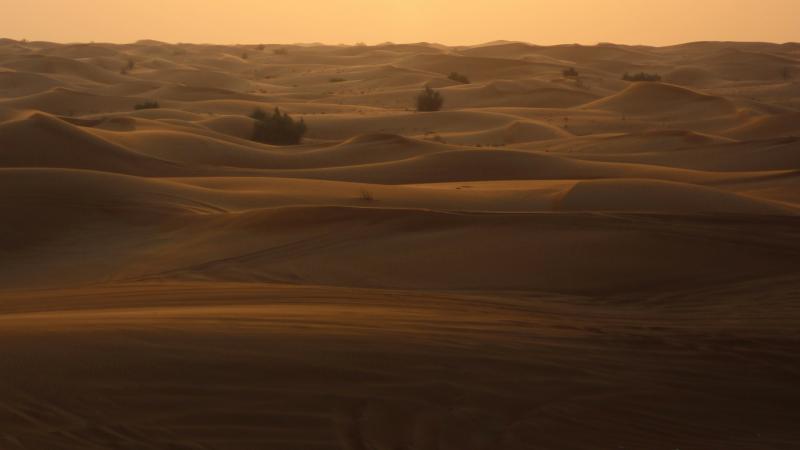
Barren landscapes, arid soil and wind-patterned sand dunes perfectly form the landscape of the Thar desert in northwest India. Can you believe that the seemingly inhospitable, parched terrain is home to a spectacular range of plant and animal species? Yes, the Great Indian bustards, Chinkaras (Indian gazelle), desert cats and Indian foxes, and different species of raptors such as vultures, eagles and falcons call the Thar desert their home. But did you also know that the extreme environment is also rich in microbial diversity? A new study by researchers from the Auckland University of Technology, New Zealand and the Maharshi Dayanand Saraswati University, India, has revealed that there is a rich variety of microbes present in the soils, dunes and the porous rocks (cryptoendolithic substrates) present in the Thar desert.
Deserts lack water, and exhibit a wider than normal difference in daily minimum and maximum temperatures. Hence, plants and animals that grow in arid conditions are stressed for survival. However, microbial communities are able to cope with such extreme dryness and thrive following subsequent rains. This ability to adapt to changing environments allows them to assume vital ecological roles in such climes. They regulate water and nutrient cycles in the deserts and help in eroding rocks, reducing soil erosion and uplifting of dust to the atmosphere.
In the present study, the researchers have chosen to study the microbial diversity in the Thar Desert - a monsoon desert with mean annual precipitation varying from 100-500mm. The soil here is semi-arid to arid, and due to comparatively slow wind in the region, there are relatively stable dunes. These features are conducive to the growth of desert microbes in the open soil, dunes and lithic niches—the focus of this study. The researchers have also studied many macro-climatic factors to determine distribution and interaction of the desert microbes.
So, how is the Thar desert formed? “As the southwest winds of the Indian Ocean move towards the land, and the monsoon crosses India, it loses moisture on the eastern slopes of the Aravalli Range. This leads to the formation of a desert”, explains Dr. Ashish Bhatnagar, one of the authors of the study, published in the Indian Journal of Microbiology.
The researchers began by assessing the microbial diversity of fungi as well as non-nucleated single celled organisms - archaea and bacteria from six locations in Ajmer, Jaisalmer, Jaipur and Jodhpur. These sampling sites included semi-arid and arid soils, arid dunes and dry, empty spaces or pores inside rocks (cryptoendolithic substrates) that microorganisms inhabit to hide.
Then, they analyzed the genetic material of these microbes using a technique called Polymerase Chain Reaction (PCR).
The study found that actinomycetes (bacteria performing photosynthesis without splitting water and releasing oxygen) as well as some Gram negative bacteria dominated both semi-arid and arid soils, rock pores were dominated surprisingly by bacteria (which perform plant-like photosynthesis), while fungi dominated the dunes. The archaea were a minor component of all communities. Based on this observation, the researchers infer that microbes in the deserts clustered according to their habitat type, rather than location.
To compare different microbes and understand their evolutionary relationship, the researchers identified the different classes of microbes in the region and found that most of them belonged to the common desert microorganisms found elsewhere. They also found that soils were consistently more biodiverse than dunes or cryptoendolithic communities.
So what drives the distribution of the microbes? The researchers opine that since organic content of the soil decreases as aridity increases, mean annual rainfall and maximum yearly temperatures best explain the observed microbial distribution. The results indicated that water availability and upper limits of temperature drove diversity. Salinity and pH of the environment influenced the adaptation of microbial communities to temperature and moisture variations, found the study. The researchers conclude that microbial diversity and their community structure in the desert environment is a consequence of salinity and not the nutrients needed for growth.
Interestingly, the researchers found that fungi dominated the sand dunes while soils were dominated mostly by bacteria. The researchers predict that this could be because the fungi have mechanisms to protect themselves against ultraviolet radiation or are adapted to arid habitats. This difference, they propose, may reflect broader adaptation of fungi to the dune environment, explained best by their interlinked chain-like growth on a relatively unstable surface.
Living organisms and their by-products create a layer of soil particles (1-4 mm) bound together by organic materials, which is called the biological soil crust. In deserts, organisms that live in these crusts play a significant role in nutrient holding and stabilization of dunes. The present study found many bacterial and fungal groups to be similar to organisms that live on these biological soil crusts.
The researchers identify that the increase in subsistence farming is now threatening this diversity of microorganisms. Practices like tilling disturb the distribution and subsequent functioning of microbial communities, they argue. “Practices adopted by farmers and the crops they decide to cultivate, govern the effects of agricultural practices on the existing collection of microorganisms”, remarks Dr. Bhatnagar. “In the future, we plan to assess the impact of microbial diversity on the process of stabilization of dunes, elemental cycles in the deserts, management of desert vegetation and microfloral diversity”, he adds, talking about the future of the research.
Who knew there was a thriving life lurking in the hostile environments of the deserts? With the aid of advanced biotechnological tools, such studies not only augment our understanding of the extreme climates but also help us assess the nature of our interaction with them.






